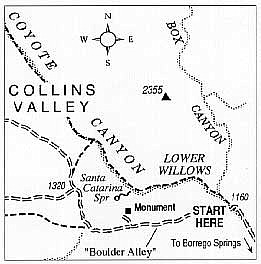 Facebook
Facebook
 X
X
 Instagram
Instagram
 TikTok
TikTok
 Youtube
Youtube
Anza-Borrego's Coyote Canyon, northwest of Borrego Springs, sustains the only dependably year-round stream in San Diego County's desert quarter. Near the lower end of the canyon, soggy Lower Willows, along with its primary source of water, Santa Catarina Spring, supports jungle-like growths of riparian vegetation. That, in turn, shelters migrant and resident birds and wildlife such as coyotes, foxes, bighorn sheep, and an occasional mountain lion.
In 1988, the original primitive road through Lower Willows was closed in order to protect the wilderness values of this rare patch of green. Ever since, traffic bound for the upper part of the canyon has been shunted over a rough bypass road to the west. So eroded has this narrow bypass become in recent years that it's earned the nickname "Boulder Alley."
To see Lower Willows today, you may approach it by car (high-clearance recommended, 4-wheel drive may be required), and go by foot from there. As the winter months go by, birds and wildlife greatly increase in number, and daily high temperatures soar from an average 70 degrees now to the 80s or even 90s by March. You may find the canyon pathways to be muddy, so wear old shoes and bring an extra pair to leave in the car. Potable water is a must.
Make sure you have a parking permit ($5 daily) from Anza-Borrego Desert State Park, available from the state park visitors' center near Borrego Springs or from various retail establishments in the town itself. Then, find Di Giorgio Road (just east of Borrego Springs) and drive north to where the pavement ends. Proceed north another 5.6 miles, using good judgment about at least two wet crossings of Coyote Creek. Conditions vary widely; after heavy rains the crossings may be impassable for all but the most nimble vehicles. Hopefully you'll get to the spot where the road swings west and climbs Boulder Alley.
On foot now, simply head up-canyon on whatever path you can find. The rampant growth of vegetation, largely willows, mesquite, tamarisk, and arrowweed, has obliterated traces of the old auto route. Listen for the monosyllabic hoot of the phainopepla, a winter-resident bird that flits about with white wing patches flashing in the bright sunlight.
After almost two miles, you come to the end of the dense willows. The open desert floor of Collins Valley lies ahead. A trail branches left (southwest), skirting the marshy Santa Catarina Spring and leading toward the nearest dirt road in the valley. You may turn back when you reach that trail, for a round trip of four miles -- or, for a somewhat longer and drier looping return route, follow the trail and road south to a bluff overlooking Santa Catarina Spring, then east down Boulder Alley.


Anza-Borrego's Coyote Canyon, northwest of Borrego Springs, sustains the only dependably year-round stream in San Diego County's desert quarter. Near the lower end of the canyon, soggy Lower Willows, along with its primary source of water, Santa Catarina Spring, supports jungle-like growths of riparian vegetation. That, in turn, shelters migrant and resident birds and wildlife such as coyotes, foxes, bighorn sheep, and an occasional mountain lion.
In 1988, the original primitive road through Lower Willows was closed in order to protect the wilderness values of this rare patch of green. Ever since, traffic bound for the upper part of the canyon has been shunted over a rough bypass road to the west. So eroded has this narrow bypass become in recent years that it's earned the nickname "Boulder Alley."
To see Lower Willows today, you may approach it by car (high-clearance recommended, 4-wheel drive may be required), and go by foot from there. As the winter months go by, birds and wildlife greatly increase in number, and daily high temperatures soar from an average 70 degrees now to the 80s or even 90s by March. You may find the canyon pathways to be muddy, so wear old shoes and bring an extra pair to leave in the car. Potable water is a must.
Make sure you have a parking permit ($5 daily) from Anza-Borrego Desert State Park, available from the state park visitors' center near Borrego Springs or from various retail establishments in the town itself. Then, find Di Giorgio Road (just east of Borrego Springs) and drive north to where the pavement ends. Proceed north another 5.6 miles, using good judgment about at least two wet crossings of Coyote Creek. Conditions vary widely; after heavy rains the crossings may be impassable for all but the most nimble vehicles. Hopefully you'll get to the spot where the road swings west and climbs Boulder Alley.
On foot now, simply head up-canyon on whatever path you can find. The rampant growth of vegetation, largely willows, mesquite, tamarisk, and arrowweed, has obliterated traces of the old auto route. Listen for the monosyllabic hoot of the phainopepla, a winter-resident bird that flits about with white wing patches flashing in the bright sunlight.
After almost two miles, you come to the end of the dense willows. The open desert floor of Collins Valley lies ahead. A trail branches left (southwest), skirting the marshy Santa Catarina Spring and leading toward the nearest dirt road in the valley. You may turn back when you reach that trail, for a round trip of four miles -- or, for a somewhat longer and drier looping return route, follow the trail and road south to a bluff overlooking Santa Catarina Spring, then east down Boulder Alley.
